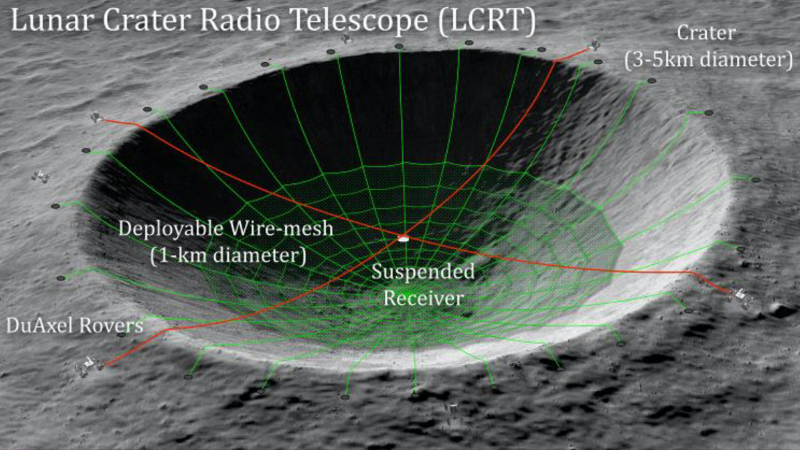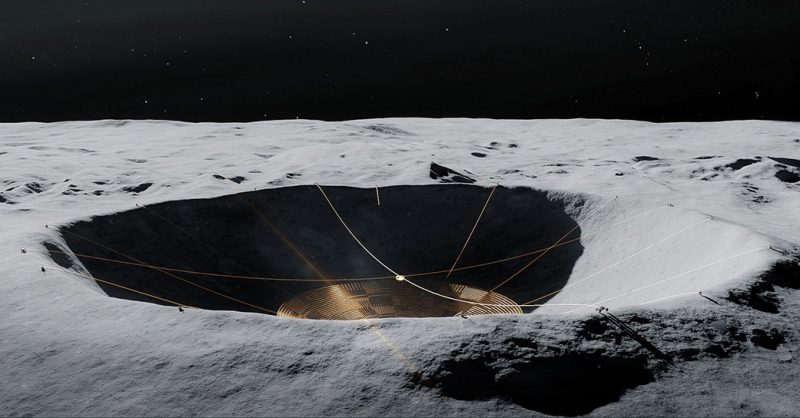Did The Chinese Really Put A Telescope On The Moon

In tardily 2022, the beloved Arecibo radio telescope in Puerto Rico collapsed and was decommissioned. It was a dish-type radio telescope, built into a natural depression in the mural. At present, as the astronomy community mourns Arecibo'southward loss, a team of scientists has just cleared another hurdle to building a much-larger radio telescope. In Apr 2022, NASA'southward Innovative Advanced Concepts awarded the Lunar Crater Radio Telescope project $500,000 for further research and development. This telescope, too, is to be built into a natural depression in the mural, in this case a bowl-shaped crater on the far side of the moon.
Where and how would a telescope be built in such a remote and inaccessible identify? After all, so far, only one spacecraft has successfully soft-landed on the moon's far side, and that is Red china's Chang'e 4, which accomplished humanity's first soft landing on the far side on January 3, 2022. To scientists, Chang'due east iv'due south success but shows information technology can be washed, and the Lunar Crater Radio Telescope team has an innovative plan. Their idea is to deploy infinite robots to build the half-mile-wide (i-km-wide) radio telescope in one of several proposed craters on the far side of the moon. The telescope itself is to consist of a wire mesh.
DuAxel is a robotic concept under evolution that would consist of two tethered rovers. One rover would stay on the edge of the crater and act as an anchor, while the second rover would travel downward the crater's wall into the bowl to build the telescope. A carve up spacecraft would deliver a wire mesh dish to the center of the crater that the robots would unfold and drag up the walls of the crater to anchor on the rim.
The design of the wire mesh itself will exist challenging, because information technology must be strong, flexible and lightweight. The mesh volition accept to maintain a precise spacing and parabolic shape while nevertheless beingness able to withstand temperature ranges from -280 degrees Fahrenheit (-173 C) to 260 degrees Fahrenheit (127 C).
Tin can it be done? Should it be done? The fact is, a radio telescope on the far side of the moon has been a long-held dream of space visionaries.

A radio telescope on the moon's far side would take many advantages over a similar instrument built on Earth. While large radio telescopes exercise be on Earth (the biggest one, currently, is FAST in China), our ionosphere blocks Globe-bound radio telescopes from seeing wavelengths longer than 33 feet (10 meters). The moon'south lack of an atmosphere volition permit the longer radio wavelengths to reach a telescope built on the moon. And the far side of the moon is an excellent site for a radio telescope. That'southward because the moon itself will block the radio chatter emitted from Earth. These advantages will open a range of wavelengths that astronomers take not been able to explore. As Saptarshi Bandyopadhyay of JPL, leader of the Lunar Crater Radio Telescope research team, said about Earth'due south limiting factors:
There's a whole region of the universe that we only cannot run into.
NASA said on May v, 2022, that admission to the longer radio wavelengths, via the Lunar Crater Radio Telescope, will be particularly constructive for probing the universe's Night Ages. This period in our universe's early history happened subsequently the Big Bang and before the first stars. The time period straight after the Big Bang can be studied via the cosmic microwave groundwork. The Hubble Infinite Telescope (and presently the James Webb Space Telescope) can peer back in fourth dimension to the first stars and galaxies. Only our universe'southward Nighttime Ages are … well … dark. They lasted for a few hundred 1000000 years afterwards the Big Bang and might concord the answer to secrets about why our universe looks as it does. Lunar Crater Radio Telescope team member Joseph Lazio of JPL said:
While there were no stars, there was ample hydrogen during the universe's Dark Ages, hydrogen that would eventually serve as the raw material for the start stars. With a sufficiently big radio telescope off Earth, we could rail the processes that would pb to the germination of the start stars, peradventure even detect clues to the nature of dark thing.


The team will spend the next two years further developing its ideas, in the hopes that their dreams of a large radio telescope on the far side of the moon will come up to life and reveal secrets of the early on universe. Bandyopadhyay said:
The development of this concept could produce some pregnant breakthroughs along the manner, specially for deployment technologies and the use of robots to build gigantic structures off Earth. I'm proud to exist working with this diverse team of experts who inspire the world to retrieve of large ideas that can brand groundbreaking discoveries near the universe nosotros live in.

Bottom line: The team trying to make the Lunar Crater Radio Telescope a reality has been granted $500,000 to farther their development ideas. Such a large telescope on the far side of the moon would allow scientists to explore a range of radio wavelengths they tin't run into from Globe and would open the door to learning more almost the Night Ages of the universe.
Via NASA
Did The Chinese Really Put A Telescope On The Moon,
Source: https://earthsky.org/space/lunar-crater-radio-telescope-lcrt-phase-2-duaxel-radio-waves-dark-ages/
Posted by: orourkereack1945.blogspot.com


0 Response to "Did The Chinese Really Put A Telescope On The Moon"
Post a Comment